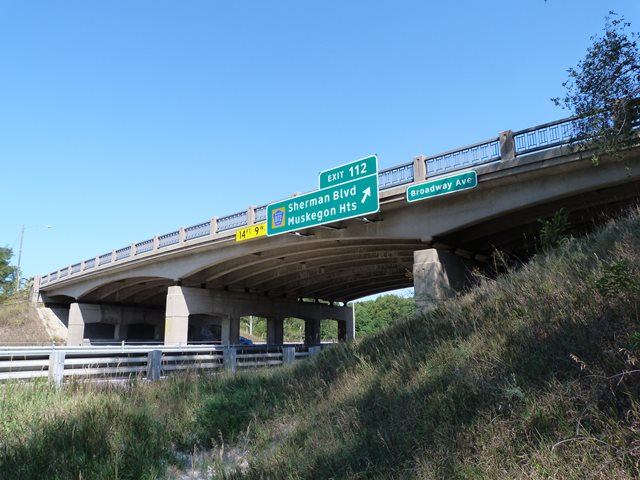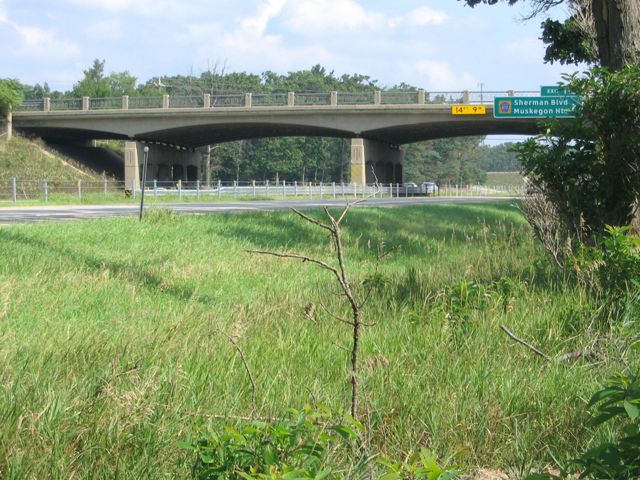We Recommend:
Bach Steel - Experts at historic truss bridge restoration.
BridgeHunter.com Phase 1 is released to the public! - Visit Now
Broadway Avenue US-31 Bridge

Primary Photographer(s): Nathan Holth
Bridge Documented: August 1, 2010 and August 7, 2012
Norton Shores: Muskegon County, Michigan: United States
1959 By Builder/Contractor: Darin and Armstrong, Inc of Detroit, Michigan and Engineer/Design: Michigan State Highway Department
Not Available or Not Applicable
58.7 Feet (17.9 Meters)
189.0 Feet (57.6 Meters)
48 Feet (14.63 Meters)
4 Main Span(s)
61161072000S020

View Information About HSR Ratings
Bridge Documentation
View Archived National Bridge Inventory Report - Has Additional Details and Evaluation
This bridge is perhaps the most technologically significant of Michigan's beautiful curved t-beam overpass bridges. There are several reasons for this. First, at least among those examples which remain with original R4 type railings and have not been widened with modern beams, this bridge which carries four lanes of traffic appears to be one of the widest surviving examples, if not the widest surviving example. As a wider example, the bridge has a slightly higher degree of technological significance. The primary source of technological significance however is the fact that the bridge's deck and superstructure follows a curve, and furthermore the bridge has super-elevation (in other words, a banked curve) to accommodate driving safety and stability needs associated with this curve. The curve may not be readily apparent to motorists driving on US-31, but anyone on Broadway Avenue can clearly see the curve as well as the super-elevation. Under the bridge, the super-elevation is clearly apparent since the piers have a stepped design such that the beams on one side of the bridge are higher than those on the other side. Thus, the Broadway Avenue Bridge is further distinguished as one of the only examples, if not the only example, of a curved t-beam with a super-elevated, curved deck as well.
Because of the aforementioned abnormalities in this particular bridge's design, this structure stands out among Michigan's remaining curved t-beam overpasses as an unusual and complex example of its type. It is further significant for its high degree of historic integrity including original railings and plaques. Furthermore, at the time of photo-documentation, this bridge did not even have modern Armco guardrails plastered onto the R4 railings like most of the remaining curved t-beams that retain original R4 railings. As bridges such as this one age and historic bridge inventories are updated, this particular bridge should be found eligible for listing in the National Register of Historic Places in the near future.
Michigan's curved t-beams represent some of the most beautiful limited access highway (freeway) bridge work conducted in the mid-20th Century. The use of gracefully curved t-beams combined with Michigan's uniquely decorative R4 railing standard resulted in an overpass that was aesthetically superior to overpasses being built in other states during the same period in history.
This bridge is tagged with the following special condition(s): Unorganized Photos
![]()
Photo Galleries and Videos: Broadway Avenue US-31 Bridge
Bridge Photo-Documentation
Original / Full Size PhotosA collection of overview and detail photos. This gallery offers photos in the highest available resolution and file size in a touch-friendly popup viewer.
Alternatively, Browse Without Using Viewer
![]()
Bridge Photo-Documentation
Mobile Optimized PhotosA collection of overview and detail photos. This gallery features data-friendly, fast-loading photos in a touch-friendly popup viewer.
Alternatively, Browse Without Using Viewer
![]()
Additional Unorganized Photos
Original / Full Size PhotosA supplemental collection of photos that are from additional visit(s) to the bridge and have not been organized or captioned. This gallery offers photos in the highest available resolution and file size in a touch-friendly popup viewer.
Alternatively, Browse Without Using Viewer
![]()
Additional Unorganized Photos
Mobile Optimized PhotosA supplemental collection of photos that are from additional visit(s) to the bridge and have not been organized or captioned. This gallery features data-friendly, fast-loading photos in a touch-friendly popup viewer.
Alternatively, Browse Without Using Viewer
![]()
Maps and Links: Broadway Avenue US-31 Bridge
Coordinates (Latitude, Longitude):
Search For Additional Bridge Listings:
Bridgehunter.com: View listed bridges within 0.5 miles (0.8 kilometers) of this bridge.
Bridgehunter.com: View listed bridges within 10 miles (16 kilometers) of this bridge.
Additional Maps:
Google Streetview (If Available)
GeoHack (Additional Links and Coordinates)
Apple Maps (Via DuckDuckGo Search)
Apple Maps (Apple devices only)
Android: Open Location In Your Map or GPS App
Flickr Gallery (Find Nearby Photos)
Wikimedia Commons (Find Nearby Photos)
Directions Via Sygic For Android
Directions Via Sygic For iOS and Android Dolphin Browser
USGS National Map (United States Only)
Historical USGS Topo Maps (United States Only)
Historic Aerials (United States Only)
CalTopo Maps (United States Only)


